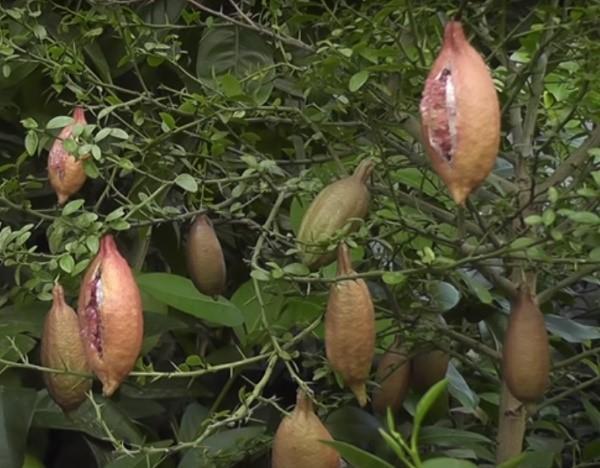Microcitrus Australasica: growing a curiosity at home - finger lime
 Although citrus crops are grown today by many growers, there are some plants that are not often found. Among them is the microcytrus Australasica, an unusual thorny tree with fruits filled with "citrus caviar". It is known in the scientific literature as the finger lime for its elongated fruit shape. And although their appearance has changed dramatically, the sour lemon taste has been preserved.
Although citrus crops are grown today by many growers, there are some plants that are not often found. Among them is the microcytrus Australasica, an unusual thorny tree with fruits filled with "citrus caviar". It is known in the scientific literature as the finger lime for its elongated fruit shape. And although their appearance has changed dramatically, the sour lemon taste has been preserved.
What does finger lime look like
The homeland of this outlandish plant is distant Australia, where several species grow. As a cultivated variety, the fruits of which are eaten, microcytrus was discovered relatively recently. It is presented mainly by hybrid varieties that have improved taste.
The Australian lime grows in the form of a bush or a short tree. It has almost horizontal shoots and very small green leaves, no more than 1 cm long and only 5 mm wide. It is noteworthy that the shoots of the plant are densely covered with sharp thorns. It is not surprising that it almost never occurs as a houseplant. Microcytrus is grown mainly by amateur gardeners.
In terms of the degree of "prickly" and inaccessibility, the microcytrus of Australasica surpasses even the thorns.
Lime blooms with very small pinkish three-petalled flowers, which themselves are pollinated. The fruit is elongated, like a very stretched lemon... Top covered with a dense shell, which, as it ripens, acquires a pink tint and cracks. A distinctive feature of the plant is the pulp of the fruit. Rather, it is not even pulp, but large "citrus caviar" in the form of juicy pink balls.
Microcitrus fruits, caviar itself, tastes sour. Most often it is used to decorate confectionery. But they ripen for a long time - almost 9 months.
Microcitrus Australasica: cultivation features
As for citrus, finger lime is quite unpretentious. Drought-resistant, tolerates high and low (relatively) temperatures. But nevertheless, culture has some requirements, in principle not particularly complicated.
In order for a lime tree to develop well and bear fruit, it must provide:
- Good lighting. This is one of the most important conditions, because in its homeland, microcytrus has a lot of sun. It should be kept on the south side. If there is not enough light, small leaves will begin to crumble.
- Seasonal feeding. They are made from March to the end of October. It is necessary to alternate in 10 days the slurry and the mineral complex.
- Cool wintering. Indoors, lime in winter stops its development due to the short daylight hours. During this period, the temperature of the content should not exceed 10 ° C.
- Formation. Since flower buds are tied only on the shoots of the 4th order, the bush must be cut. Thus, the development of lateral buds is stimulated.
Australasica reproduces mainly by grafting. You can make it on a seedling of any citrus plant: lemon, orange, grapefruit, tangerine. However, it should be noted that most varieties of finger limes bear fruit late. The first crop can be obtained 5 years after grafting.